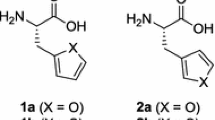Abstract
The application of designer peptides in medicinal chemistry, chemical biology, and materials science has generated new interest in synthetic methods for the structural modification of amino acids. Strategies which facilitate the direct diversification of proteinogenic functional groups within unprotected peptide substrates are particularly attractive as they leverage modern solution- and solid-phase protocols—tools which are now both robust and routine—for the synthesis of native peptides. Accordingly, a recent approach to the decarboxylative functionalization of peptidic carboxylic acids, including aspartic/glutamic acid residues and α-carboxylic acids, has proven to be a promising new strategy for peptide modification. This synthetic method merges conventional strategies for the activation of carboxylic acids with transition metal-catalyzed cross-coupling chemistry to forge new C–C bonds for the late-stage introduction of valuable synthetic handles. This chapter details a step-by-step protocol for the activation and nickel-catalyzed decarboxylative alkylation of a simple peptide substrate to highlight the broad utility of this strategy for the synthesis of designer peptides.
Access this chapter
Tax calculation will be finalised at checkout
Purchases are for personal use only
Similar content being viewed by others
References
Palomo JM (2014) Solid-phase peptide synthesis: an overview focused on the preparation of biologically relevant peptides. RSC Adv 4(62):32658–32672. https://doi.org/10.1039/C4RA02458C
Conibear AC, Watson EE, Payne RJ, Becker CFW (2018) Native chemical ligation in protein synthesis and semi-synthesis. Chem Soc Rev 47(24):9046–9068. https://doi.org/10.1039/C8CS00573G
Kulkarni SS, Sayers J, Premdjee B, Payne RJ (2018) Rapid and efficient protein synthesis through expansion of the native chemical ligation concept. Nat Rev Chem 2:0122. https://doi.org/10.1038/s41570-018-0122
deGruyter JN, Malins LR, Baran PS (2017) Residue-specific peptide modification: a chemist’s guide. Biochemistry 56(30):3863–3873. https://doi.org/10.1021/acs.biochem.7b00536
Koniev O, Wagner A (2015) Developments and recent advancements in the field of endogenous amino acid selective bond forming reactions for bioconjugation. Chem Soc Rev 44(15):5495–5551. https://doi.org/10.1039/C5CS00048C
Walsh CT, Garneau-Tsodikova S, Gatto GJ Jr (2005) Protein posttranslational modifications: the chemistry of proteome diversifications. Angew Chem Int Ed Engl 44(45):7342–7372. https://doi.org/10.1002/anie.200501023
Spicer CD, Davis BG (2014) Selective chemical protein modification. Nat Commun 5:4740. https://doi.org/10.1038/ncomms5740
Hoyt EA, Cal PMSD, Oliveira BL, Bernardes GJL (2019) Contemporary approaches to site-selective protein modification. Nat Rev Chem 3:147–171. https://doi.org/10.1038/s41570-019-0079-1
Malins LR (2018) Decarboxylative couplings as versatile tools for late-stage peptide modifications. Pept Sci 110(3):e24049. https://doi.org/10.1002/pep2.24049
deGruyter JN, Malins LR, Wimmer L, Clay KJ, Lopez-Ogalla J, Qin T, Cornella J, Liu Z, Che G, Bao D, Stevens JM, Qiao JX, Allen MP, Poss MA, Baran PS (2017) CITU: a peptide and decarboxylative coupling reagent. Org Lett 19(22):6196–6199. https://doi.org/10.1021/acs.orglett.7b03121
Cornella J, Edwards JT, Qin T, Kawamura S, Wang J, Pan CM, Gianatassio R, Schmidt M, Eastgate MD, Baran PS (2016) Practical Ni-catalyzed aryl-alkyl cross-coupling of secondary redox-active esters. J Am Chem Soc 138(7):2174–2177. https://doi.org/10.1021/jacs.6b00250
Qin T, Cornella J, Li C, Malins LR, Edwards JT, Kawamura S, Maxwell BD, Eastgate MD, Baran PS (2016) A general alkyl-alkyl cross-coupling enabled by redox-active esters and alkylzinc reagents. Science 352(6287):801–805. https://doi.org/10.1126/science.aaf6123
Edwards JT, Merchant RR, McClymont KS, Knouse KW, Qin T, Malins LR, Vokits B, Shaw SA, Bao DH, Wei FL, Zhou T, Eastgate MD, Baran PS (2017) Decarboxylative alkenylation. Nature 545(7653):213–218. https://doi.org/10.1038/nature22307
Smith JM, Qin T, Merchant RR, Edwards JT, Malins LR, Liu Z, Che G, Shen Z, Shaw SA, Eastgate MD, Baran PS (2017) Decarboxylative alkynylation. Angew Chem Int Ed Engl 56(39):11906–11910. https://doi.org/10.1002/anie.201705107
Li C, Wang J, Barton LM, Yu S, Tian M, Peters DS, Kumar M, Yu AW, Johnson KA, Chatterjee AK, Yan M, Baran PS (2017) Decarboxylative borylation. Science 356(6342):eaam7355. https://doi.org/10.1126/science.aam7355
Author information
Authors and Affiliations
Corresponding author
Editor information
Editors and Affiliations
Rights and permissions
Copyright information
© 2020 Springer Science+Business Media, LLC, part of Springer Nature
About this protocol
Cite this protocol
Zhang, M.Y., Malins, L.R. (2020). Decarboxylative Couplings for Late-Stage Peptide Modifications. In: Hussein, W., Skwarczynski, M., Toth, I. (eds) Peptide Synthesis. Methods in Molecular Biology, vol 2103. Humana, New York, NY. https://doi.org/10.1007/978-1-0716-0227-0_19
Download citation
DOI: https://doi.org/10.1007/978-1-0716-0227-0_19
Published:
Publisher Name: Humana, New York, NY
Print ISBN: 978-1-0716-0226-3
Online ISBN: 978-1-0716-0227-0
eBook Packages: Springer Protocols




